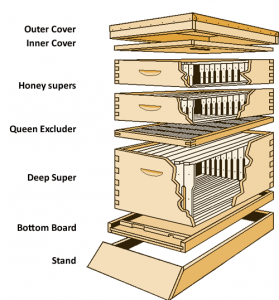What makes a great bee hive? That’s a complicated question that keepers have tried to answer for as long as we’ve kept bees; striking a balance between healthy, maintainable and productive.
 Our earliest ancestors probably harvested wild honey whenever the opportunity arose. We have depictions of rock art of humans gathering honey with smoke and we have even found remains of beeswax used as tooth-fillings. Both activities are still in practice in some regions to this day. However, we probably only starting cultivating bees in hives in Neolithic times.
Our earliest ancestors probably harvested wild honey whenever the opportunity arose. We have depictions of rock art of humans gathering honey with smoke and we have even found remains of beeswax used as tooth-fillings. Both activities are still in practice in some regions to this day. However, we probably only starting cultivating bees in hives in Neolithic times.
Hollowed out logs and later, clay vessels, were probably our first attempts at man-made hives. From depictions and remains, we find that the later were horizontal cylinders of clay with an entrance hole at one end and removable lid at the other. There is also evidence that we began to selectively breeding for milder and more productive strains of bees around this time as well.
 Much later, wicker basket or “skep” style hives became popular in parts of Europe and wooden boxes in China. While these hives were somewhat easier to maintain, harvesting was still a fairly destructive and less efficient process. The liquid honey from the destroyed brood nest was crudely strained through a sieve or basket. The destruction of the bee colony in this manner meant the loss of a valuable resource. This drawback made beekeeping both inefficient and something of a “stop and start” activity.
Much later, wicker basket or “skep” style hives became popular in parts of Europe and wooden boxes in China. While these hives were somewhat easier to maintain, harvesting was still a fairly destructive and less efficient process. The liquid honey from the destroyed brood nest was crudely strained through a sieve or basket. The destruction of the bee colony in this manner meant the loss of a valuable resource. This drawback made beekeeping both inefficient and something of a “stop and start” activity.
In many areas, “top bar” hives emerged as an attempt to address these shortcomings. They incorporated larger access and hanging “bars” within to try to direct where and how the bees built their combs. These types of hives continued to develop and variations are popular to this day for their simplicity.
 However, it was not until the 18th century that hives and beekeeping saw a revolution in technique and design in the West. Innovations such as expandable layout, easily movable frames and the ability to observe & inspect hives throughout the season. This movement culminated with the Langstroth hive, one of the most popular honey production hives to this day. This type of hive incorporates standardized sizes, interchangeable parts, modular design, a maintenance & harvest oriented design and a variety of supplemental equipment for specialized needs.
However, it was not until the 18th century that hives and beekeeping saw a revolution in technique and design in the West. Innovations such as expandable layout, easily movable frames and the ability to observe & inspect hives throughout the season. This movement culminated with the Langstroth hive, one of the most popular honey production hives to this day. This type of hive incorporates standardized sizes, interchangeable parts, modular design, a maintenance & harvest oriented design and a variety of supplemental equipment for specialized needs.
I use the Langstroth hive because it felt intuitive to me and makes it easy for me to harvest honey and perform inspections & maintenance to keep hives healthy with the least disruption to the bees.